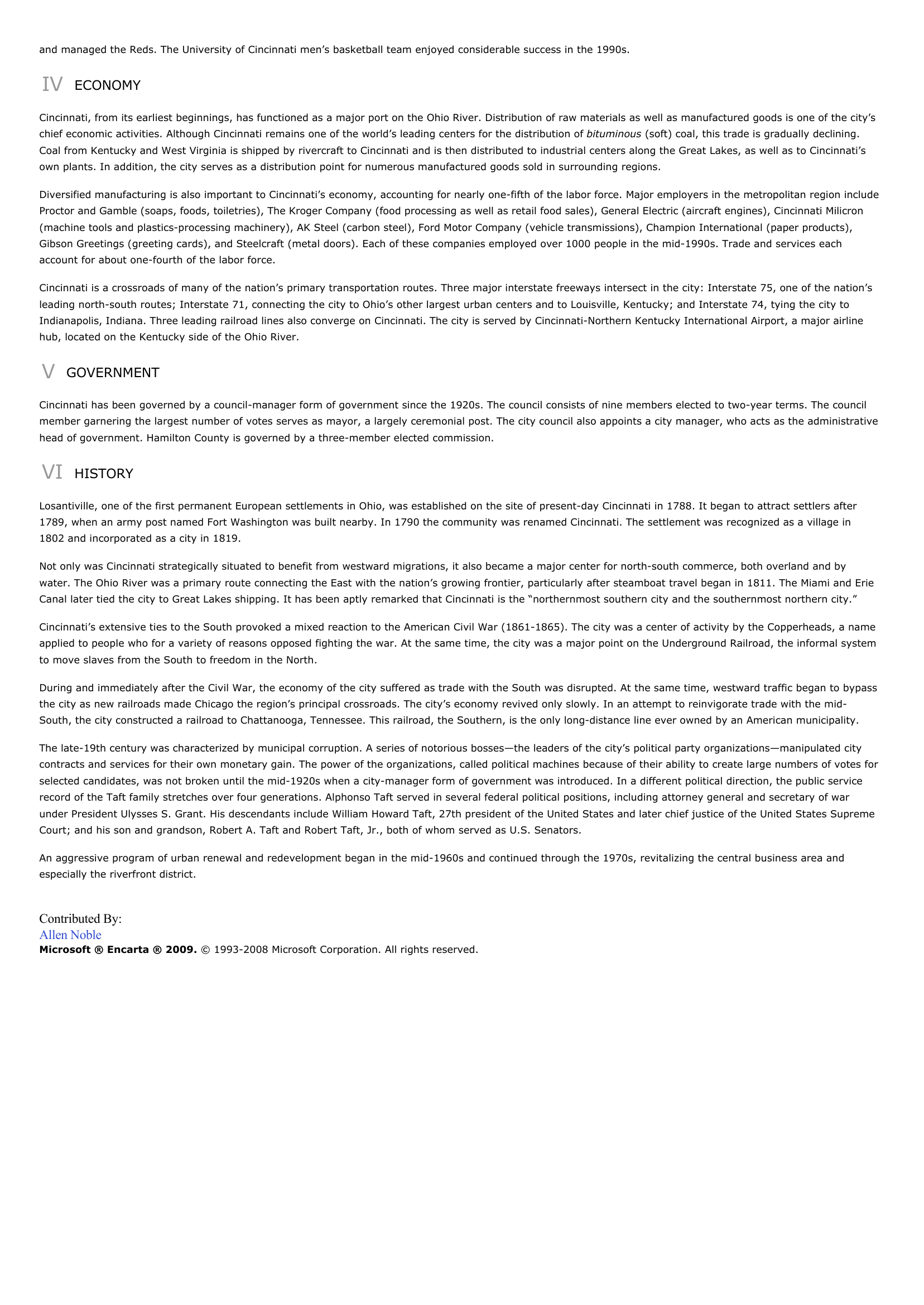Cincinnati - geography.
Publié le 04/05/2013

Extrait du document
«
and managed the Reds.
The University of Cincinnati men’s basketball team enjoyed considerable success in the 1990s.
IV ECONOMY
Cincinnati, from its earliest beginnings, has functioned as a major port on the Ohio River.
Distribution of raw materials as well as manufactured goods is one of the city’schief economic activities.
Although Cincinnati remains one of the world’s leading centers for the distribution of bituminous (soft) coal, this trade is gradually declining. Coal from Kentucky and West Virginia is shipped by rivercraft to Cincinnati and is then distributed to industrial centers along the Great Lakes, as well as to Cincinnati’sown plants.
In addition, the city serves as a distribution point for numerous manufactured goods sold in surrounding regions.
Diversified manufacturing is also important to Cincinnati’s economy, accounting for nearly one-fifth of the labor force.
Major employers in the metropolitan region includeProctor and Gamble (soaps, foods, toiletries), The Kroger Company (food processing as well as retail food sales), General Electric (aircraft engines), Cincinnati Milicron(machine tools and plastics-processing machinery), AK Steel (carbon steel), Ford Motor Company (vehicle transmissions), Champion International (paper products),Gibson Greetings (greeting cards), and Steelcraft (metal doors).
Each of these companies employed over 1000 people in the mid-1990s.
Trade and services eachaccount for about one-fourth of the labor force.
Cincinnati is a crossroads of many of the nation’s primary transportation routes.
Three major interstate freeways intersect in the city: Interstate 75, one of the nation’sleading north-south routes; Interstate 71, connecting the city to Ohio’s other largest urban centers and to Louisville, Kentucky; and Interstate 74, tying the city toIndianapolis, Indiana.
Three leading railroad lines also converge on Cincinnati.
The city is served by Cincinnati-Northern Kentucky International Airport, a major airlinehub, located on the Kentucky side of the Ohio River.
V GOVERNMENT
Cincinnati has been governed by a council-manager form of government since the 1920s.
The council consists of nine members elected to two-year terms.
The councilmember garnering the largest number of votes serves as mayor, a largely ceremonial post.
The city council also appoints a city manager, who acts as the administrativehead of government.
Hamilton County is governed by a three-member elected commission.
VI HISTORY
Losantiville, one of the first permanent European settlements in Ohio, was established on the site of present-day Cincinnati in 1788.
It began to attract settlers after1789, when an army post named Fort Washington was built nearby.
In 1790 the community was renamed Cincinnati.
The settlement was recognized as a village in1802 and incorporated as a city in 1819.
Not only was Cincinnati strategically situated to benefit from westward migrations, it also became a major center for north-south commerce, both overland and bywater.
The Ohio River was a primary route connecting the East with the nation’s growing frontier, particularly after steamboat travel began in 1811.
The Miami and ErieCanal later tied the city to Great Lakes shipping.
It has been aptly remarked that Cincinnati is the “northernmost southern city and the southernmost northern city.”
Cincinnati’s extensive ties to the South provoked a mixed reaction to the American Civil War (1861-1865).
The city was a center of activity by the Copperheads, a nameapplied to people who for a variety of reasons opposed fighting the war.
At the same time, the city was a major point on the Underground Railroad, the informal systemto move slaves from the South to freedom in the North.
During and immediately after the Civil War, the economy of the city suffered as trade with the South was disrupted.
At the same time, westward traffic began to bypassthe city as new railroads made Chicago the region’s principal crossroads.
The city’s economy revived only slowly.
In an attempt to reinvigorate trade with the mid-South, the city constructed a railroad to Chattanooga, Tennessee.
This railroad, the Southern, is the only long-distance line ever owned by an American municipality.
The late-19th century was characterized by municipal corruption.
A series of notorious bosses—the leaders of the city’s political party organizations—manipulated citycontracts and services for their own monetary gain.
The power of the organizations, called political machines because of their ability to create large numbers of votes forselected candidates, was not broken until the mid-1920s when a city-manager form of government was introduced.
In a different political direction, the public servicerecord of the Taft family stretches over four generations.
Alphonso Taft served in several federal political positions, including attorney general and secretary of warunder President Ulysses S.
Grant.
His descendants include William Howard Taft, 27th president of the United States and later chief justice of the United States SupremeCourt; and his son and grandson, Robert A.
Taft and Robert Taft, Jr., both of whom served as U.S.
Senators.
An aggressive program of urban renewal and redevelopment began in the mid-1960s and continued through the 1970s, revitalizing the central business area andespecially the riverfront district.
Contributed By:Allen NobleMicrosoft ® Encarta ® 2009. © 1993-2008 Microsoft Corporation.
All rights reserved..
»
↓↓↓ APERÇU DU DOCUMENT ↓↓↓
Liens utiles
- Cincinnati - geography.
- Taft William Howard , 1857-1930, né à Cincinnati (Ohio), homme d'État américain.
- Spielberg Steven, né en 1947 à Cincinnati (Ohio), cinéaste américain.
- Power Tyrone, 1913-1958, né à Cincinnati (Ohio), acteur américain.
- Farrell (Suzanne Ficker, dite Suzanne), née en 1945 à Cincinnati (Ohio), danseuse américaine.





